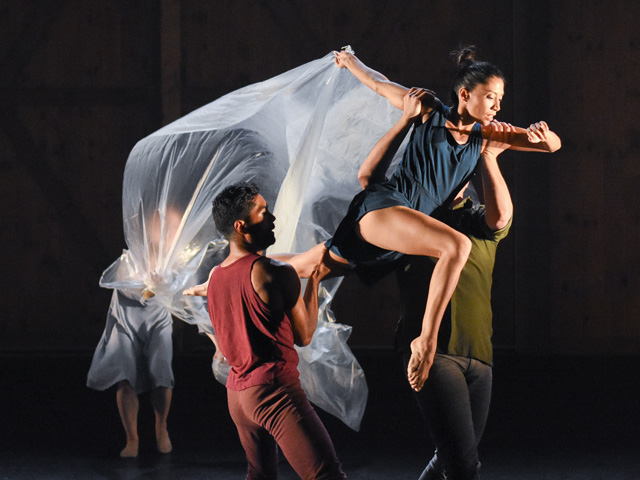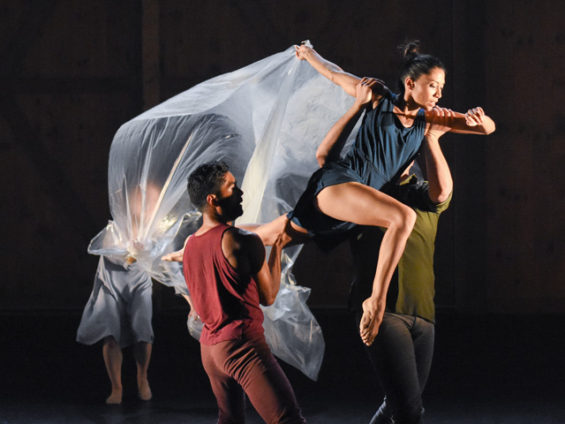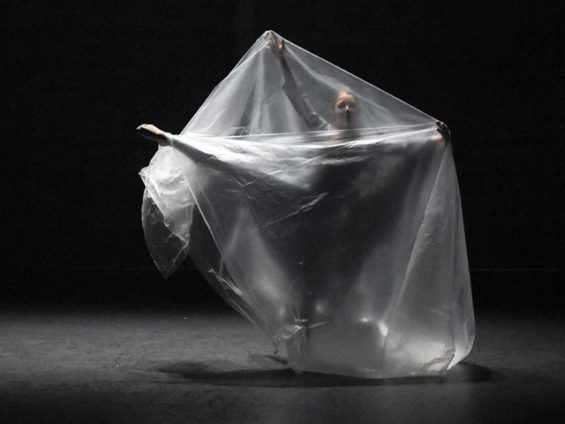Dance Review: Umanoove and The Happiness Project


Estela Merlos (lifted) of Umanoove/Didy Veldman in “The Happiness Project” (photo by Grace Kathryn Landefeld, courtesy of Jacob’s Pillow).
Happiness is tricky. It’s something we all want, but it often feels just out of reach—that if we do this, buy that, go there, we’ll find it, wrapped and waiting like a birthday gift. The fleeting, often elusive quality of happiness lies at the center of The Happiness Project, a 2016 work by Dutch-born choreographer Didy Veldman, whose company, Umanoove, makes its U.S. debut at Jacob’s Pillow this week.
The Happiness Project is sometimes poignant, even if there is nothing groundbreaking about the performance. It uses a familiar contemporary European dance vocabulary, interpreted through the lens of Veldman’s physical, grounded style and expressive fluidity. Still, when the dancers let loose in some of the more expansive passages, moving simultaneously but not in unison, and during a pas de tois filled with complicated partnering and transitions, it’s beautiful.
What the work does best is reflect the human condition. The Happiness Project is an examination of the nature of our relationships—dyadic, though not always romantic, and group—and how they influence our happiness. Sometimes we’re rewarded; sometimes not. This in-between space is something Umanoove excels at capturing.
The Happiness Project also points out the folly in some of the ways we seek joy. In one witty section, the dancers embody it through the attainment of possessions—in this case, designer clothing and accessories. Ultimately, one dancer, who manages to collect all of the items for himself, triumphantly dons a coat, only to discover that it’s tethered to a box, restricting his movement.

Madeleine Jonsson of Umanoove/Didy Veldman in “The Happiness Project” (photo by Grace Kathryn Landefeld, courtesy of Jacob’s Pillow).
One of Veldman’s greatest strengths lies in finding extraordinary dancers. All four are exceptional, and when they dance together, it’s hard to choose who to watch. Using such a small group of dancers also creates an intimacy larger companies can’t accomplish. The propulsive, partly live score by Romanian composer Alexander Balanescu is also lovely, but his physical presence in the piece feels unnecessary.
Umanoove is at its best when painting very specific pictures through movement and staging, including the costumes, which are unfussy but beautiful in their rich jewel palette. That said, The Happiness Project is heavily reliant on props. In addition to the designer items, the dancers use lighted boxes, plastic bags and sheets, and markers throughout the performance. It gets a little shticky toward the end, though the section where a female dancer performs while swathed in a plastic sheet, wrapping it alternately around her head and body (above), or leaving in trailing behind her, seems to suggest a plastic-encased bride running toward—or away from?—a traditional romantic relationship.
So are we truly happy? Can we become happy simply by forcing a smile or a laugh, or pursuing a relationship? Perhaps the message of The Happiness Project is best summed up by author Eckhart Tolle: “Don’t seek happiness. If you seek it, you won’t find it, because seeking it is the antithesis of happiness.”
Watch a post-show talk with choreographer Didy Veldman and composer Alexander Balanescu.